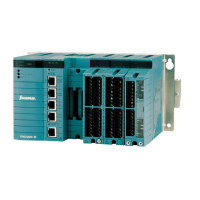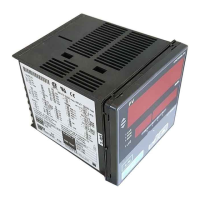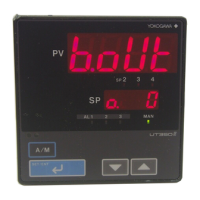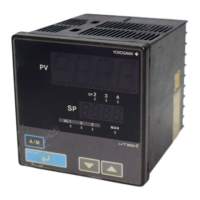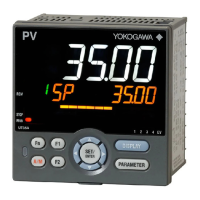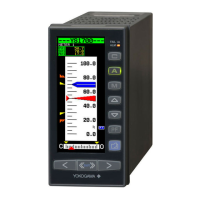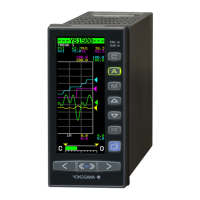4-10 IM 04L20A01-01E
Setup Items
Alarm Output, Alarm Type
• First-CH/Last-CH
Set the target channel for setting the alarm output. The target channels are common
with the range setting.
• Off/On
Up to 4 alarms can be set to a single channel. For each of the alarms [1] to [4], select
[On] to enable an alarm, [Off] to disable it. If [On] is selected, [Type], [Value], and
[Rly] (Relay) entry boxes appear.
• Type
Select the alarm type (conditions for activating the alarm) from the following eight
types.
Name Symbol Description
Upper limit alarm H An alarm occurs when the measured/computed value is
greater than or equal to the alarm value.
Lower limit alarm L An alarm occurs when the measured/computed value is
less than or equal to the alarm value.
Difference h An alarm occurs when the difference in the measured
upper limit alarm
*1
values of two channels is greater than or equal to the
difference high limit alarm value.
Difference l An alarm occurs when the difference in the measured
lower limit alarm
*1
values of two channels is less than or equal to the
difference low limit alarm value.
Upper limit on R The rate-of-change of the measured values is checked
rate-of-change alarm
*2
over a certain interval (set using the [Increase] entry box
of basic alarm settings). An alarm occurs if the rate-of-
change of the measured value in the rising direction is
greater than or equal to the specified value.
Lower limit on r The rate-of-change of the measured values is checked
rate-of-change alarm
*2
over a certain interval (set using the [Decrease] entry box
of basic alarm settings). An alarm occurs if the rate-of-
change of the measured value in the falling direction is
less than or equal to the specified value.
Delay upper limit alarm T An alarm occurs when the measured value remains above
or equal to the alarm value for the specified delay.
Delay lower limit alarm t An alarm occurs when the measured value remains below
or equal to the alarm value for the specified delay.
*1 Can only be specified on difference computation channels.
*2 Can only be specified on measurement channels.
• Value
Set the alarm value for the selected alarm type.
• Rly
Select whether relay output is enabled [On] or disabled [Off]. If [On] is selected, the
[Number] entry box appears.
• No.
Set the alarm output relay number to output the relay contact signal from the terminal
of the option terminal block. Selectable relays are [I01] and [I02] (/A1 option), [I01] to
[I04] (/A2 option), or [I01] to [I06] (/A3 option). For the correspondence between the
output relay numbers and the positions of the terminals of the terminal blocks, see
pages 2-9 and 2-10.
4.2 Setting Alarm Related Parameters

